Delivery Methods
Delivery Methods define how audio and text files generated by the phone system are delivered to users. These files include voicemails, notification messages, faxes, and call recordings.
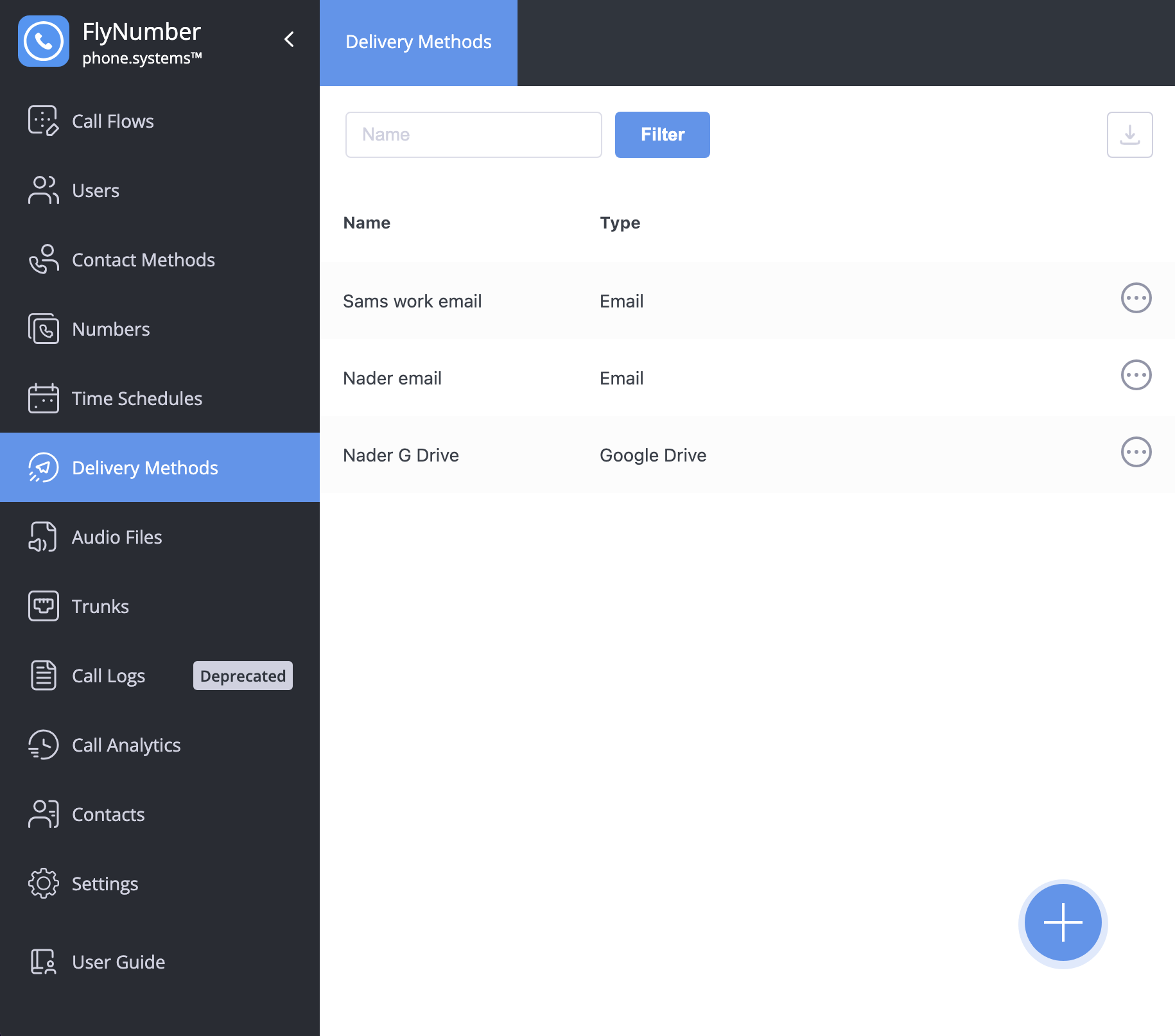
Available Variables
When configuring delivery methods, you can use these variables to customize file names and messages:
%{src_number}- Caller's phone number%{src_name}- Caller's name%{dst_number}- Called phone number%{service_name}- Service type (Voicemail, Fax, etc.)%{call_time}- Full date and time (YYYY-MM-DD HH-MM-SS)%{call_year}- Year of call%{call_month}- Month of call%{call_day}- Day of call%{call_hour}- Hour of call
Use these variables to create dynamic, informative file names and notifications. For example:
- File name:
%{service_name}-%{src_number}-%{call_time} - Email subject: "New
%{service_name}from%{src_number}"
Supported Methods
The phone system supports several delivery methods:
| Method | Best For |
|---|---|
| Quick delivery of messages, multiple recipients | |
| Dropbox | Team sharing and cloud storage |
| FTP | Custom server integration |
| SFTP | Secure file transfers |
| Google Drive | Cloud storage and sharing |
| OneDrive | Microsoft ecosystem integration |
Module Delivery Options
Different modules support different delivery methods:
| Module/Feature | Available Delivery Methods |
|---|---|
| Voicemail | Email, Dropbox, FTP, SFTP, Google Drive, OneDrive |
| Call Recorder | Email, Dropbox, FTP, SFTP, Google Drive, OneDrive |
| Fax | Email, Dropbox, FTP, SFTP, Google Drive, OneDrive |
| Notification | Email only |
| SIP Account call recording | Email, Dropbox, FTP, SFTP, Google Drive, OneDrive |
For app-based recording, you can configure delivery methods in two ways:
-
Using Contact Methods (Primary Method)
- Go to Contact Methods (left hand side main menu)
- Select the App Configurations Tab
- Configure recording settings in the Call Recording section
-
Using Ring Group Module (Optional)
- Add a Ring Group module to your call flow
- Set your app user as a Queue Destination
- Access app configuration settings through the Ring Group
- For details, see Ring Group App Configuration Settings
The Notification module is limited to email delivery only, while other modules support the full range of delivery options.
Creating a Delivery Method
To create a new delivery method:
- Click the + button in the bottom right corner
- Select your delivery method type:

Email Configuration
- Add one or more email addresses
- Verify each email address
- Perfect for team distribution lists
Cloud Storage Options
- Dropbox
- Google Drive
- OneDrive
- Requires authorization with the service
- Automatically creates a dedicated folder
FTP/SFTP Setup
- Server address
- Username and password
- Optional: Custom port and path
- Supports secure connections
You can create multiple delivery methods of the same type. For example, you might have different email groups for different departments.
Managing Delivery Methods
Your delivery methods appear in a table showing:
- Method name
- Type (Email, Dropbox, etc.)
- Status (Active, Needs reauthorization)
- Action menu for management
Re-authorizing Cloud Services
Sometimes cloud services (Dropbox, Google Drive, OneDrive) need to be re-authorized due to:
- Expired access tokens
- Revoked permissions
- Service disconnections
When this happens:
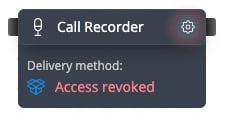
- The status will show "Access revoked"
- Edit the delivery method
- Click the Refresh button
- Follow the service's authorization process
Modules using a delivery method that needs re-authorization will display a warning icon until fixed.
Deleting a Delivery Method
Before deleting a delivery method:
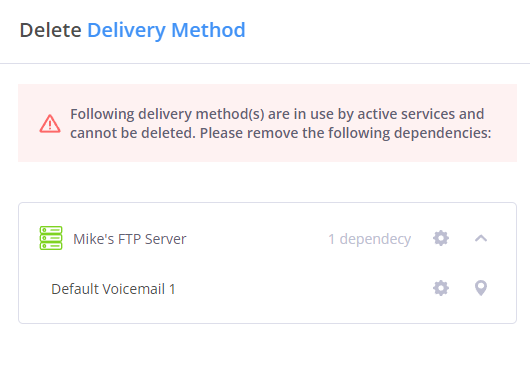
- Check for dependencies
- Remove the method from any modules using it
- Click the Actions menu (⋮)
- Select Delete
- Confirm the deletion
You cannot delete a delivery method that's in use. The system will show you which modules are using the method, and you'll need to update those modules first.
Best Practices
-
Email Delivery
- Use descriptive names for easy identification
- Verify all email addresses before use
- Set up distribution lists for team notifications
- Use variables to provide context in messages
- Consider email size limits for recordings
- Set up backup delivery methods
-
Cloud Storage
- Regular authorization checks
- Monitor storage space
- Use dedicated folders
-
FTP/SFTP
- Secure credential management
- Regular connection testing
- Backup storage planning
-
General Tips
- Document delivery paths
- Test new methods before use
- Regular status monitoring
- Keep authorizations current
For important messages, consider setting up multiple delivery methods as a backup. For example, use both email and cloud storage for critical recordings.
Email 📬
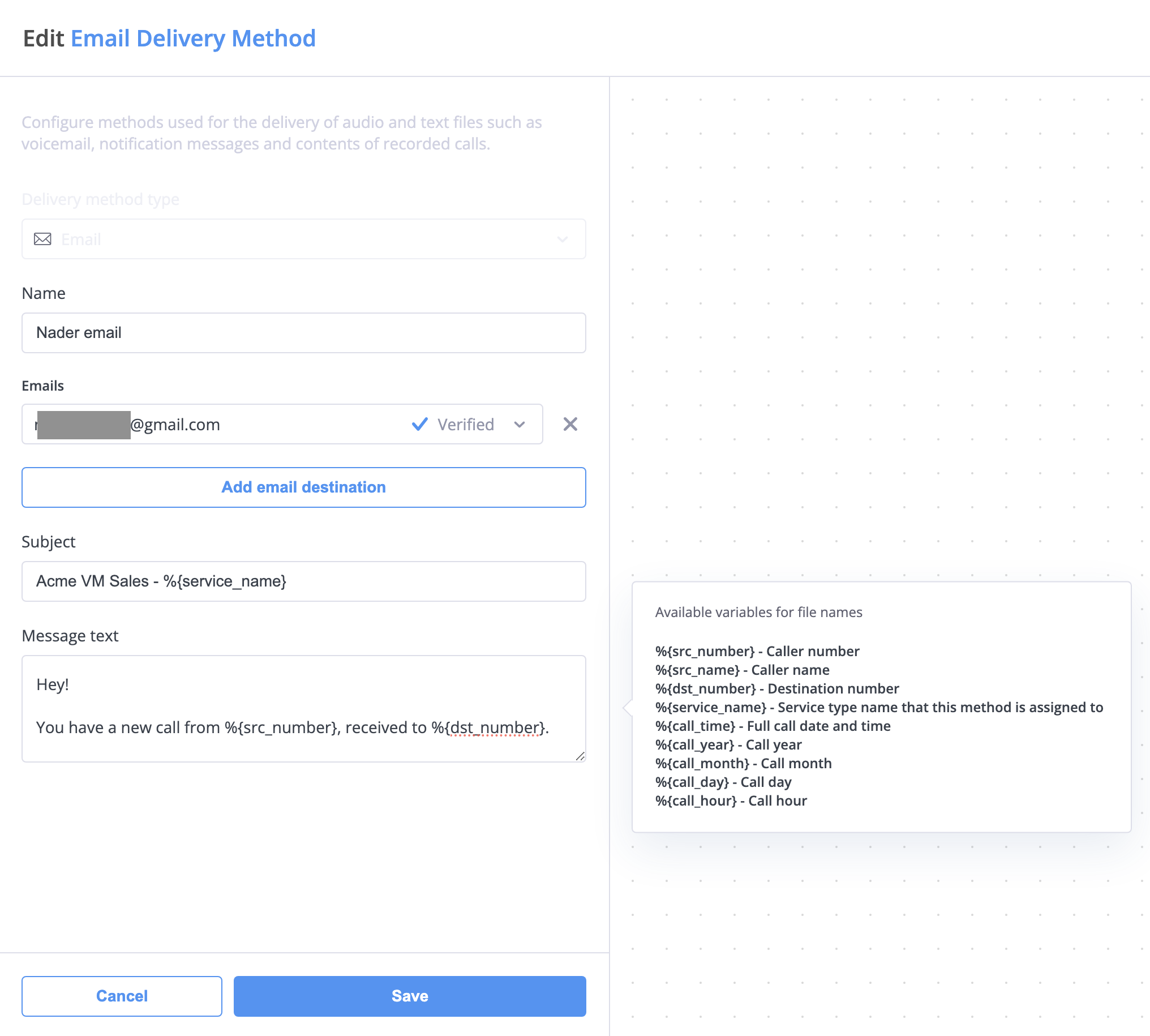
The Email delivery method supports sending notifications and recordings to multiple recipients. Configure the following settings:
-
Name: A friendly identifier for this delivery method (e.g., "Support Team Notifications")
-
Email Destinations:
- Add one or more email addresses
- Each email requires verification before use
- Click "Add email destination" for multiple recipients
- Remove addresses using the X icon
-
Subject Line: Customize email subjects using variables
- Support for dynamic content
- Include relevant call details
-
Message Text: Create custom message content with:
- Personalized greetings
- Call details using variables
- Custom formatting and instructions
Google Drive ☁️
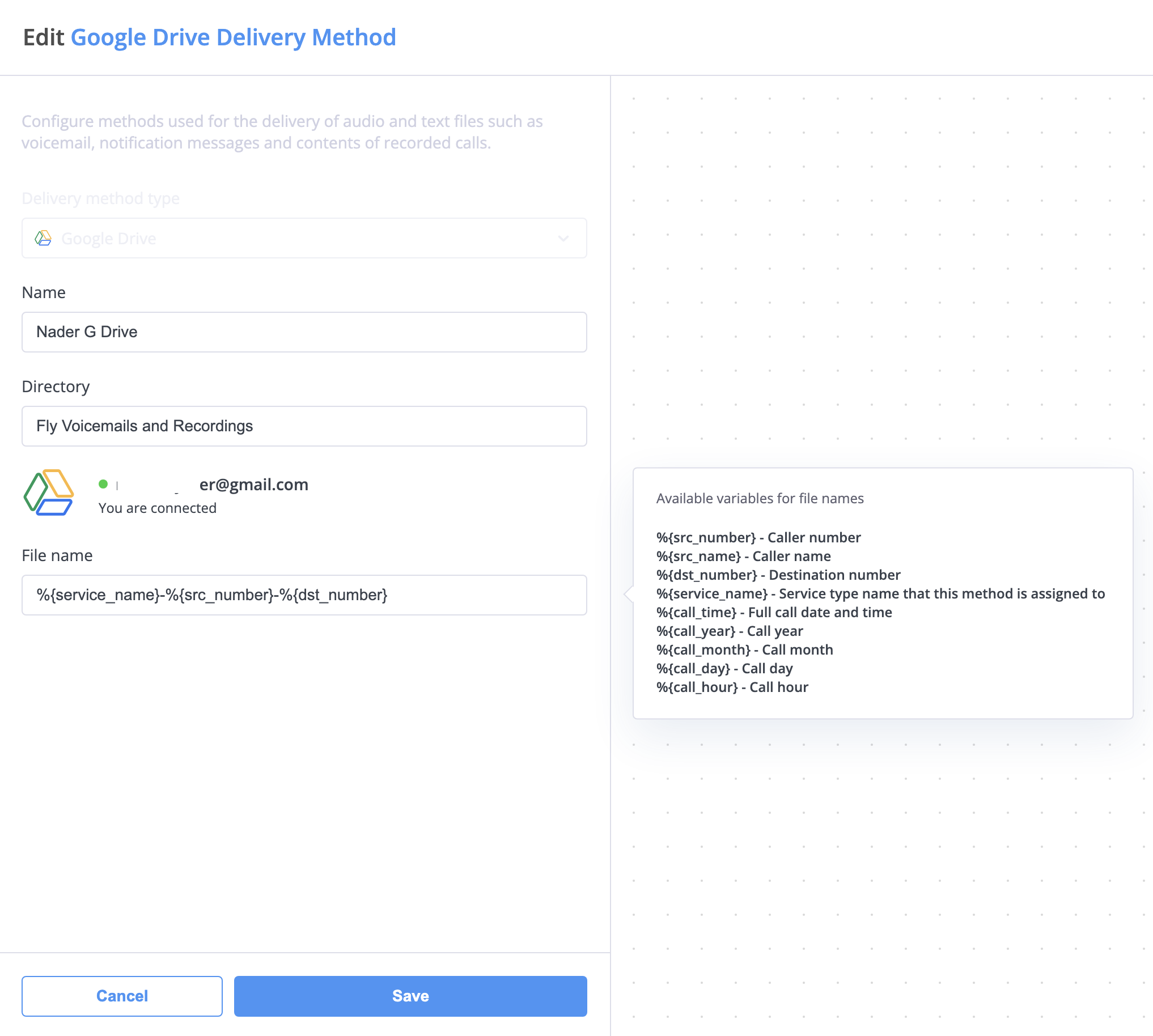
Google Drive is a cloud storage service that helps you store, share, and collaborate on files and folders from any mobile device, tablet, or computer. The Google Drive delivery method automatically saves your recordings and messages to your Drive account.
Configure the following settings:
-
Name: A friendly identifier for this delivery method (e.g., "Call Recordings Storage")
-
Directory: Specify where files will be stored:
- Enter a folder name
- The folder will be created if it doesn't exist
- Use forward slashes for nested folders (e.g., "Recordings/2024")
-
File Name Format: Customize how files are named using variables
You must have a Google Drive account and authorize the phone system to access it. Click the "Connect" button to link your account when setting up the delivery method.
Create a clear file naming structure using variables to make it easy to find specific recordings later. For example:
%{service_name}-%{src_number}-%{call_time} will create files like "Voicemail-14155551234-2024-01-20-15-30-45"
Dropbox ☁️
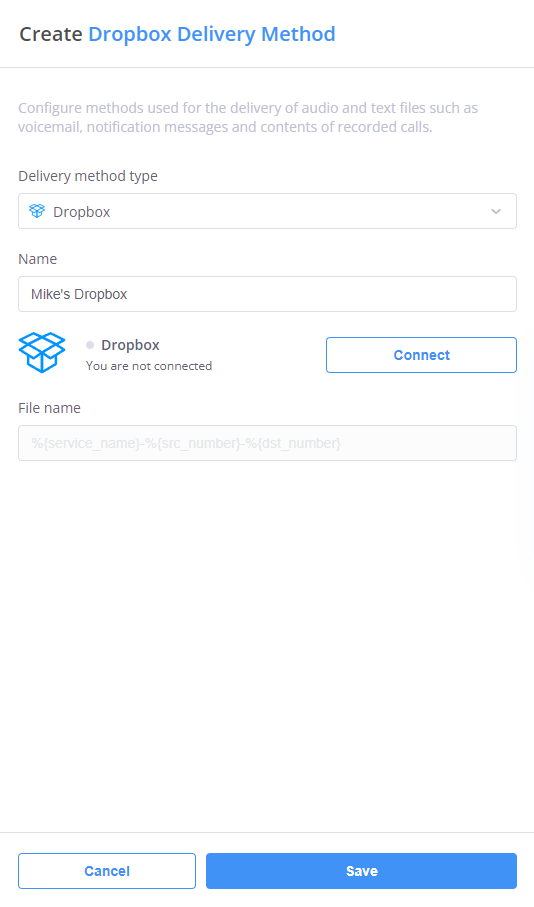
Dropbox is a cloud storage service that helps you store and share files across devices and teams. The Dropbox delivery method automatically saves your recordings and messages to your Dropbox account, making them accessible from any device.
Configure the following settings:
-
Name: Give your delivery method a descriptive name (e.g., "Team Recordings" or "Support Voicemails")
-
File Name Format: Customize how files are named using variables:
- Create consistent naming patterns
- Make files easily searchable
You'll need to connect your Dropbox account by clicking the "Connect" button during setup. The phone system will create a dedicated app folder to store your files.
Consider creating a naming convention that includes the date and type of recording for easy organization. For example:
%{call_year}/%{call_month}/%{service_name}-%{src_number}
This will create a folder structure like "2024/01/Voicemail-14155551234"
OneDrive ☁️
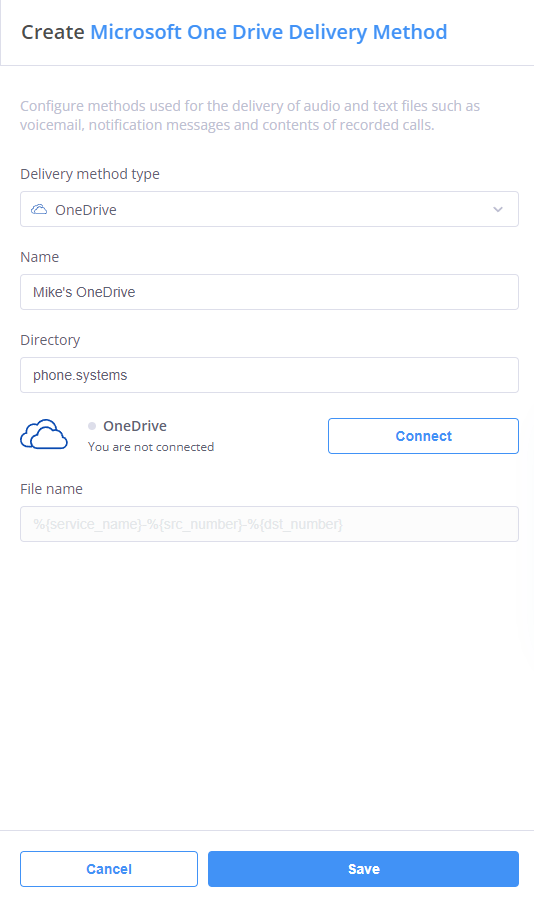
Microsoft OneDrive is a cloud storage platform that integrates with Microsoft 365 services. The OneDrive delivery method automatically stores your recordings and messages in your OneDrive account, ideal for businesses using the Microsoft ecosystem.
Configure the following settings:
-
Name: Choose a descriptive name for your delivery method (e.g., "Business Recordings" or "Team Messages")
-
Directory: Specify the folder path for your files:
- Enter the desired folder name
- Use forward slashes for nested folders
- Folders are created automatically if they don't exist
-
File Name Format: Customize file names using variables:
- Structure names for easy organization
- Include relevant call details
You must have a Microsoft account and authorize the phone system to access your OneDrive. Click the "Connect" button during setup to link your account.
For business environments, consider organizing files by department and date:
Department/%{call_year}-%{call_month}/%{service_name}
This creates an organized structure like "Sales/2024-01/Voicemail"
FTP 📂
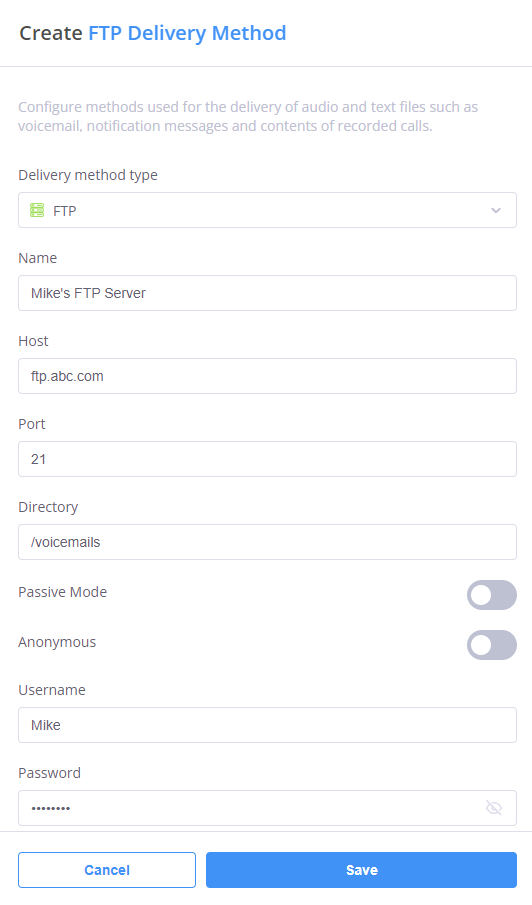
FTP (File Transfer Protocol) is a standard network protocol for transferring files between computers. Think of it as a dedicated system for moving files across the internet - like having a special folder that automatically sends files to your server. It's commonly used by businesses that want to store files on their own servers rather than cloud services.
Configure the following settings:
-
Name: Give your delivery method a descriptive name (e.g., "Company FTP Server")
-
Host: Enter your FTP server address
-
Port: Specify the port number (default is 21)
-
Directory: Set the folder path for storing files:
- Use forward slashes for paths
- The folder must exist on the server
- Example:
/voicemails/incoming
-
Mode Settings:
- Passive Mode: Enable for better compatibility with firewalls
- Anonymous: Enable to connect without credentials (not recommended)
-
Authentication:
- Username: Your FTP account username
- Password: Your FTP account password
-
File Name Format: Customize how files are named using variables
FTP transfers data in plain text, which means it's not encrypted. For sensitive information, consider using SFTP instead.
Test your FTP connection with a small file first to ensure all settings are correct. Common issues include:
- Incorrect port numbers
- Firewall blocking connections
- Wrong directory permissions
SFTP 🔒
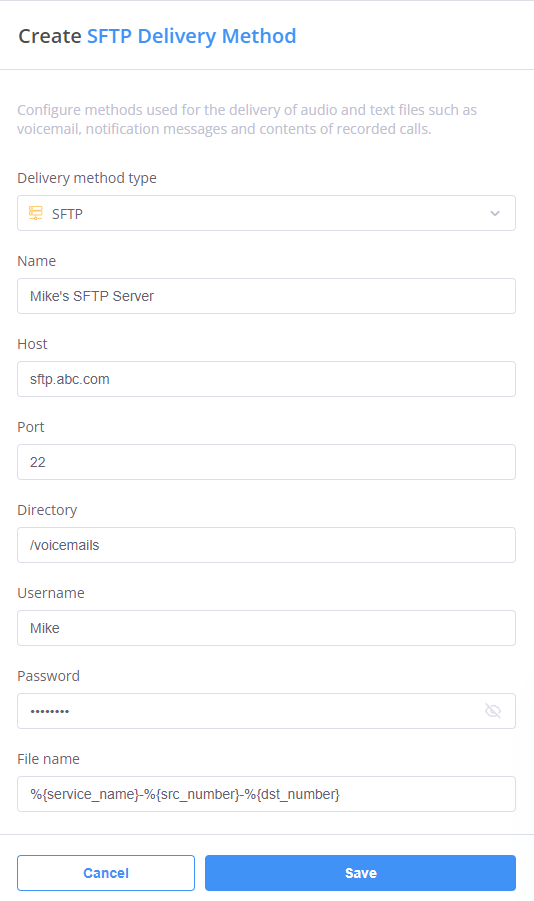
SFTP (SSH File Transfer Protocol) is a secure version of FTP that encrypts all data during transfer. It provides the same file transfer capabilities as FTP but with added security - like having a locked, private tunnel for your files to travel through. This makes it ideal for businesses handling sensitive information.
Configure the following settings:
-
Name: Choose a descriptive name (e.g., "Secure Company Server")
-
Host: Enter your SFTP server address
-
Port: Specify the port number (default is 22)
-
Directory: Set the folder path for storing files:
- Use forward slashes for paths
- The folder must exist on the server
- Example:
/recordings/2024
-
Authentication:
- Username: Your SFTP account username
- Password: Your SFTP account password
-
File Name Format: Customize how files are named using variables
SFTP requires valid credentials - anonymous access is not supported. Make sure you have the correct username and password from your server administrator.
For better organization, consider using date-based directories in your path:
/recordings/%{call_year}/%{call_month}
This automatically sorts files by year and month.